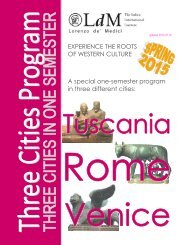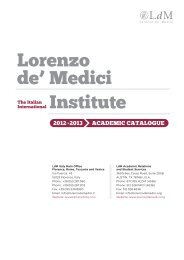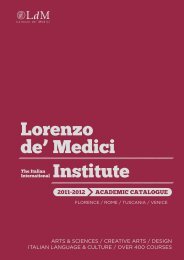aCademiC Catalog 2013-2014 - Lorenzo de Medici
aCademiC Catalog 2013-2014 - Lorenzo de Medici
aCademiC Catalog 2013-2014 - Lorenzo de Medici
You also want an ePaper? Increase the reach of your titles
YUMPU automatically turns print PDFs into web optimized ePapers that Google loves.
guest speakers, case studies and assignments stu<strong>de</strong>nts will<br />
explore issues and concerns that are involved in the strategies,<br />
conceptual structures and un<strong>de</strong>rstanding of how <strong>de</strong>sign<br />
may serve retail programs, from product to interiors. They<br />
will apply <strong>de</strong>sign to current multi-channel retail strategies in<br />
both bricks-and-mortar and web-based firms. Topics may<br />
inclu<strong>de</strong>: <strong>de</strong>velopment of a retail space format, target analysis,<br />
site selection, and corporate image management. Course<br />
assignments are <strong>de</strong>signed to enable stu<strong>de</strong>nts to improve<br />
presentation skills and the ability to comunicate <strong>de</strong>sign<br />
concepts in a clear and straightforward way.<br />
Note: It is highly recommen<strong>de</strong>d that stu<strong>de</strong>nts be equipped with<br />
a personal laptop for <strong>de</strong>sign projects.<br />
Prerequisites: INT 250 Interior Design and INT 290 CAD for<br />
Interior Design II, or equivalents<br />
Computer 3D Animation<br />
INT 375 F; Dual listed: GRA 405 F<br />
Cr: 3; Contact hrs: 90<br />
The aim of the course is to introduce stu<strong>de</strong>nts who already<br />
have a basic knowledge of static ren<strong>de</strong>ring to the next level<br />
of computer graphics: animation. Stu<strong>de</strong>nts learn to create<br />
animations of their projects in or<strong>de</strong>r to achieve a more striking<br />
impact in their presentations. Typical subjects treated inclu<strong>de</strong>:<br />
to represent flying and walking through 3D architectural<br />
spaces; to <strong>de</strong>sign objects that will be assembled using<br />
animation techniques; to control light changes during the day<br />
in interior <strong>de</strong>sign projects with time lapse animation; to propose<br />
different solutions/assets for open space offices that change<br />
dynamically; to animate logos. After having learned the basic<br />
techniques of animation stu<strong>de</strong>nts will continue to the editing<br />
process, to scripting, and to how to distribute and make visible<br />
their animated presentations in different media, from DVD to<br />
internet and mobile <strong>de</strong>vices.<br />
Prerequisites: GRA 330 Ren<strong>de</strong>ring Essentials, or INT 350<br />
Computer Ren<strong>de</strong>ring in Interior Design, or equivalents<br />
Furniture Design<br />
INT 380 F<br />
Cr: 3; Contact hrs: 90<br />
The course aims to provi<strong>de</strong> stu<strong>de</strong>nts with a basic un<strong>de</strong>rstanding<br />
of the theories and techniques in furniture <strong>de</strong>sign. The lessons<br />
examine the various <strong>de</strong>sign processes and procedures, while<br />
also consi<strong>de</strong>ring space and functional analysis of <strong>de</strong>sign. For<br />
the most part, the class will be a workshop for <strong>de</strong>sign projects.<br />
The course will also consi<strong>de</strong>r the importance of targets and<br />
visual communication signs. Stu<strong>de</strong>nts will carry out personal<br />
research on pieces of furniture, materials and <strong>de</strong>signers in or<strong>de</strong>r<br />
to explore furniture <strong>de</strong>sign and to <strong>de</strong>velop a personal style.<br />
Note: Stu<strong>de</strong>nts are highly recommen<strong>de</strong>d to be equipped with<br />
personal laptops for <strong>de</strong>sign projects.<br />
Prerequisites: 1) INT 250 Interior Design, or INT 293 Product<br />
Design 2) INT 290 CAD for Interior Design II, or equivalents<br />
Exhibit Design<br />
INT 390 F<br />
Cr: 3; Contact hrs: 90<br />
This course is based on an architectural approach to the project<br />
of exhibit areas. The project research is <strong>de</strong>veloped first in the<br />
field of temporary commercial fairs and stu<strong>de</strong>nts learn how to<br />
control space both from the functional and the aesthetic point of<br />
view and then in the field of temporary exhibitions in a museum,<br />
<strong>de</strong>aling with the difficulty of organization and presentation.<br />
During the course, stu<strong>de</strong>nts examine different basic themes<br />
and are introduced to real professional applications. The<br />
proposed projects are <strong>de</strong>veloped emphasizing conceptual and<br />
<strong>de</strong>sign research and solution to the functional and distribution<br />
problems.<br />
Note: It is highly recommen<strong>de</strong>d that stu<strong>de</strong>nts be equipped with<br />
a personal laptop for <strong>de</strong>sign projects.<br />
Prerequisites: INT 250 Interior Design and INT 290 CAD for<br />
Interior Design II, or equivalents<br />
Working Group Project in Interior Design<br />
INT 400 F<br />
Cr: 3; Contact hrs: 45<br />
In this course stu<strong>de</strong>nts will work together un<strong>de</strong>r the supervision<br />
of the professor to realize a professional group project.<br />
Note: It is highly recommen<strong>de</strong>d that stu<strong>de</strong>nts should be<br />
equipped with a personal laptop for <strong>de</strong>sign projects.<br />
Prerequisites: minimum three semesters in interior <strong>de</strong>sign<br />
Jewelry Design<br />
History of Jewels and their Symbolism<br />
JWY 150 F<br />
Cr: 3; Contact hrs: 45<br />
The course will cover the complete history of jewelry from the<br />
simple primitive shell beads to the Renaissance period and the<br />
splendor of Art Nouveau, concluding with the <strong>de</strong>velopments<br />
of the mo<strong>de</strong>rn jewelry masters. Through stylistic changes and<br />
different fashions, jewels offer a great opportunity to learn<br />
more about the history of taste during Antiquity, the Middle<br />
Ages, and the Renaissance plus works of artists during the<br />
19th and 20th centuries. We will analyze and examine pieces<br />
of jewelry and their symbolism in conjunction with paintings,<br />
architecture, and <strong>de</strong>corative artworks. Part of the course is<br />
<strong>de</strong>dicated to famous personalities in history who wore jewelry<br />
as symbolic items of power, and to the great jewelry <strong>de</strong>signers<br />
from Benvenuto Cellini to Tiffany. This course also aims to give<br />
stu<strong>de</strong>nts an in-<strong>de</strong>pth knowledge of artistic techniques, methods<br />
of documentation and a technical vocabulary. Use of sli<strong>de</strong>s and<br />
visits to museums, exhibitions and workshops in Florence will<br />
be integral parts of the course.<br />
Jewelry Design I: Drawing and Ren<strong>de</strong>ring<br />
Techniques<br />
JWY 155 F<br />
Cr: 3; Contact hrs: 90<br />
Stu<strong>de</strong>nts are introduced to the creative <strong>de</strong>sign of jewels. They<br />
start by learning first the main drawing techniques, such as<br />
orthographic projections and 3D sketches, and second the<br />
ren<strong>de</strong>ring techniques using watercolors, gouache, markers<br />
and pastels. Study resources inclu<strong>de</strong> projects by professional<br />
<strong>de</strong>signers, publications, and selected museums and exhibitions.<br />
Techniques are explained, practiced and then applied in<br />
projects, so that stu<strong>de</strong>nts <strong>de</strong>velop personal creativity while<br />
they build essential representational skills.<br />
Jewelry Design I: Drawing and Ren<strong>de</strong>ring<br />
Techniques (Summer only)<br />
JWY 156 F<br />
Cr: 3; Contact hrs: 45<br />
Stu<strong>de</strong>nts are introduced to the creative <strong>de</strong>sign of jewels. They<br />
start by learning first the main drawing techniques, such as<br />
orthographic projections and 3D sketches, and second the<br />
ren<strong>de</strong>ring techniques using watercolors, gouache, markers<br />
and pastels. Study resources inclu<strong>de</strong> projects by professional<br />
<strong>de</strong>signers, publications, and selected museums and exhibitions.<br />
Techniques are explained, practiced and then applied in<br />
projects, so that stu<strong>de</strong>nts <strong>de</strong>velop personal creativity while<br />
they build essential representational skills.<br />
Wax Carving and Casting Techniques<br />
JWY 170 F<br />
Cr: 3; Contact hrs: 90<br />
Some casting techniques will be studied in <strong>de</strong>pth, such as lost<br />
wax casting process, cuttlebone casting and sand casting. The<br />
course will inclu<strong>de</strong> the creation of a mold in cuttlebone, an<br />
in-<strong>de</strong>pth study of wax working and carving methods, and the<br />
duplication of a master mo<strong>de</strong>l with a re-usable flexible “rubber<br />
mold”. This course focuses on getting stu<strong>de</strong>nts acquainted<br />
with the hard wax carving method and the soft wax working<br />
techniques. Emphasis will be placed on preparing a <strong>de</strong>sign and<br />
a mo<strong>de</strong>l for production. The course has been structured with<br />
the objective of giving stu<strong>de</strong>nts the skills to make jewels in<br />
silver using the different casting techniques.<br />
Prerequisites: JWY 180 Jewelry Making I, or equivalent; or<br />
concurrent enrolment<br />
School of Design FLORENCE<br />
LdM Aca<strong>de</strong>mic <strong>Catalog</strong> <strong>2013</strong>-<strong>2014</strong><br />
117





